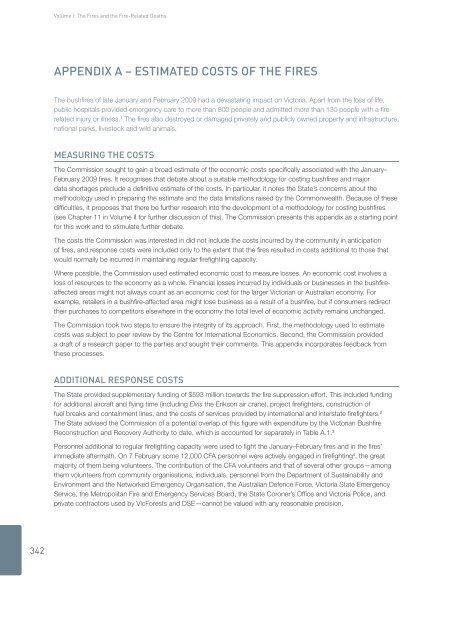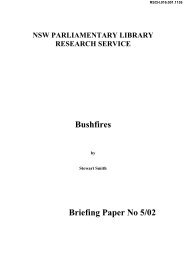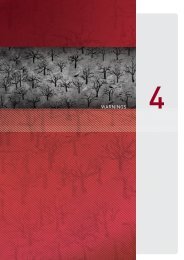APPENDIXES - 2009 Victorian Bushfires Royal Commission
APPENDIXES - 2009 Victorian Bushfires Royal Commission
APPENDIXES - 2009 Victorian Bushfires Royal Commission
You also want an ePaper? Increase the reach of your titles
YUMPU automatically turns print PDFs into web optimized ePapers that Google loves.
Volume I: The Fires and the Fire-Related Deaths<br />
APPENDIX A – Estimated costs of the fires<br />
The bushfires of late January and February <strong>2009</strong> had a devastating impact on Victoria. Apart from the loss of life,<br />
public hospitals provided emergency care to more than 800 people and admitted more than 130 people with a firerelated<br />
injury or illness. 1 The fires also destroyed or damaged privately and publicly owned property and infrastructure,<br />
national parks, livestock and wild animals.<br />
Measuring the costs<br />
The <strong>Commission</strong> sought to gain a broad estimate of the economic costs specifically associated with the January–<br />
February <strong>2009</strong> fires. It recognises that debate about a suitable methodology for costing bushfires and major<br />
data shortages preclude a definitive estimate of the costs. In particular, it notes the State’s concerns about the<br />
methodology used in preparing the estimate and the data limitations raised by the Commonwealth. Because of these<br />
difficulties, it proposes that there be further research into the development of a methodology for costing bushfires<br />
(see Chapter 11 in Volume II for further discussion of this). The <strong>Commission</strong> presents this appendix as a starting point<br />
for this work and to stimulate further debate.<br />
The costs the <strong>Commission</strong> was interested in did not include the costs incurred by the community in anticipation<br />
of fires, and response costs were included only to the extent that the fires resulted in costs additional to those that<br />
would normally be incurred in maintaining regular firefighting capacity.<br />
Where possible, the <strong>Commission</strong> used estimated economic cost to measure losses. An economic cost involves a<br />
loss of resources to the economy as a whole. Financial losses incurred by individuals or businesses in the bushfireaffected<br />
areas might not always count as an economic cost for the larger <strong>Victorian</strong> or Australian economy. For<br />
example, retailers in a bushfire-affected area might lose business as a result of a bushfire, but if consumers redirect<br />
their purchases to competitors elsewhere in the economy the total level of economic activity remains unchanged.<br />
The <strong>Commission</strong> took two steps to ensure the integrity of its approach. First, the methodology used to estimate<br />
costs was subject to peer review by the Centre for International Economics. Second, the <strong>Commission</strong> provided<br />
a draft of a research paper to the parties and sought their comments. This appendix incorporates feedback from<br />
these processes.<br />
Additional response costs<br />
The State provided supplementary funding of $593 million towards the fire suppression effort. This included funding<br />
for additional aircraft and flying time (including Elvis the Erikson air crane), project firefighters, construction of<br />
fuel breaks and containment lines, and the costs of services provided by international and interstate firefighters. 2<br />
The State advised the <strong>Commission</strong> of a potential overlap of this figure with expenditure by the <strong>Victorian</strong> Bushfire<br />
Reconstruction and Recovery Authority to date, which is accounted for separately in Table A.1. 3<br />
Personnel additional to regular firefighting capacity were used to fight the January–February fires and in the fires’<br />
immediate aftermath. On 7 February some 12,000 CFA personnel were actively engaged in firefighting 4 , the great<br />
majority of them being volunteers. The contribution of the CFA volunteers and that of several other groups—among<br />
them volunteers from community organisations, individuals, personnel from the Department of Sustainability and<br />
Environment and the Networked Emergency Organisation, the Australian Defence Force, Victoria State Emergency<br />
Service, the Metropolitan Fire and Emergency Services Board, the State Coroner’s Office and Victoria Police, and<br />
private contractors used by VicForests and DSE—cannot be valued with any reasonable precision.<br />
342
















